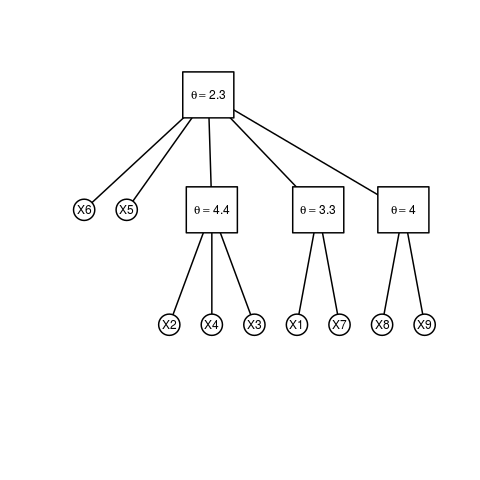Supported by Dr. Osamu Ogasawara and  providing providing  . . |
|
Last data update: 2014.03.03 |
Construction of hac objectsDescriptionhac objects are required as input argument for several functions, e.g. Usagehac(type, tree) hac.full(type, y, theta) ## S3 method for class 'hac' print(x, digits = 2, ...) hac2nacopula(x) nacopula2hac(outer_nacopula) Arguments
ValueA hac object is returned.
ReferencesHofert, M. and Maechler, M. 2011, Nested Archimedean Copulas Meet R: The Hofert, M., Kojadinovic, I., Maechler, M. and Yan, J. 2013, Kojadinovic, I., Yan, J. 2010, Modeling Multivariate Distributions with Continuous Margins Using the Okhrin, O. and Ristig, A. 2014, Hierarchical Archimedean Copulae: The Yan, J. 2007, Enjoy the Joy of Copulas: With a Package Examples
# it might be helpful to plot the hac objects
# Example 1: 4-dim AC
tree = list("X1", "X2", "X3", "X4", 2)
AC = hac(type = 1, tree = tree)
# Example 2: 4-dim HAC
y = c("X1", "X4", "X3", "X2")
theta = c(2, 3, 4)
HAC1 = hac.full(type = 1, y = y, theta = theta)
HAC2 = hac(type = 1, tree = list(list(list("X2", "X3", 4),
"X4", 3), "X1", 2))
tree2str(HAC1) == tree2str(HAC2) # [1] TRUE
# Example 3: 9-dim HAC
HAC = hac(type = 1, tree = list("X6", "X5", list("X2", "X4", "X3", 4.4),
list("X1", "X7", 3.3), list("X8", "X9", 4), 2.3))
plot(HAC)
Results
R version 3.3.1 (2016-06-21) -- "Bug in Your Hair"
Copyright (C) 2016 The R Foundation for Statistical Computing
Platform: x86_64-pc-linux-gnu (64-bit)
R is free software and comes with ABSOLUTELY NO WARRANTY.
You are welcome to redistribute it under certain conditions.
Type 'license()' or 'licence()' for distribution details.
R is a collaborative project with many contributors.
Type 'contributors()' for more information and
'citation()' on how to cite R or R packages in publications.
Type 'demo()' for some demos, 'help()' for on-line help, or
'help.start()' for an HTML browser interface to help.
Type 'q()' to quit R.
> library(HAC)
Loading required package: copula
> png(filename="/home/ddbj/snapshot/RGM3/R_CC/result/HAC/hac.Rd_%03d_medium.png", width=480, height=480)
> ### Name: hac
> ### Title: Construction of 'hac' objects
> ### Aliases: hac hac.full print.hac hac2nacopula nacopula2hac
>
> ### ** Examples
>
> # it might be helpful to plot the hac objects
> # Example 1: 4-dim AC
> tree = list("X1", "X2", "X3", "X4", 2)
> AC = hac(type = 1, tree = tree)
>
> # Example 2: 4-dim HAC
> y = c("X1", "X4", "X3", "X2")
> theta = c(2, 3, 4)
>
> HAC1 = hac.full(type = 1, y = y, theta = theta)
> HAC2 = hac(type = 1, tree = list(list(list("X2", "X3", 4),
+ "X4", 3), "X1", 2))
> tree2str(HAC1) == tree2str(HAC2) # [1] TRUE
[1] TRUE
>
> # Example 3: 9-dim HAC
>
> HAC = hac(type = 1, tree = list("X6", "X5", list("X2", "X4", "X3", 4.4),
+ list("X1", "X7", 3.3), list("X8", "X9", 4), 2.3))
> plot(HAC)
>
>
>
>
>
> dev.off()
null device
1
>
|
